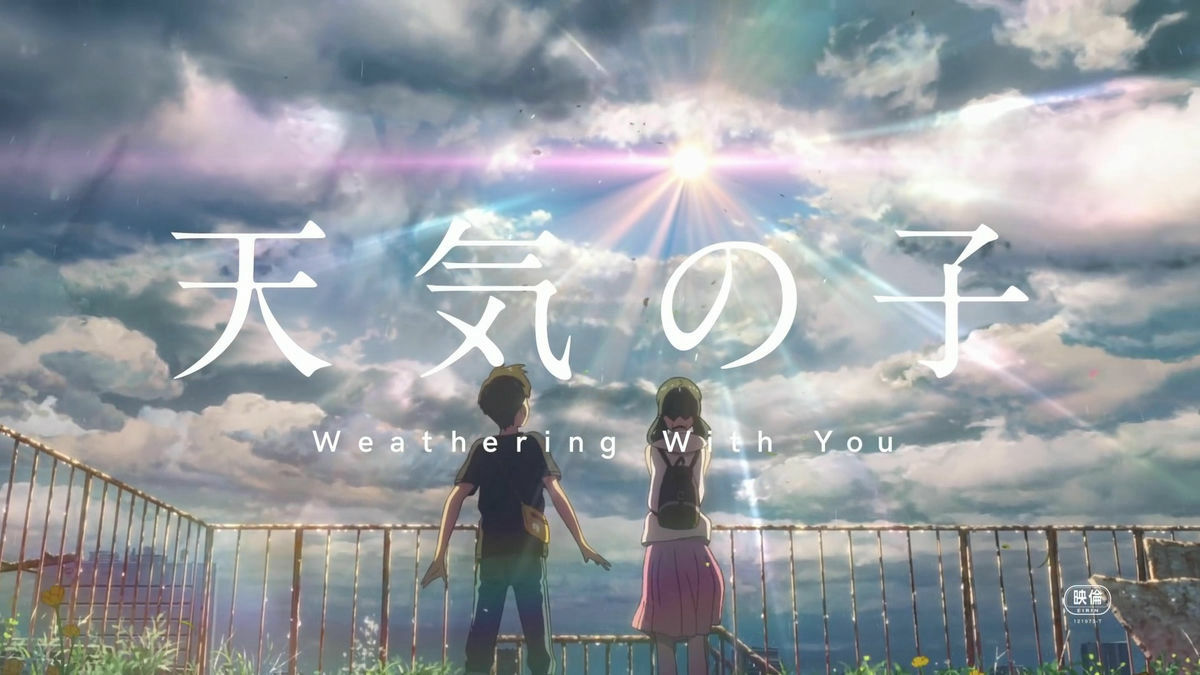
Tenki no Ko (Weathering With You) is finally out in US cinemas this week! Check out showtimes here.
Warning: Major spoilers ahead for Tenki no Ko and other Makoto Shinkai works. Proceed at your own risk.
Kimi no Na wa. (Your Name.)'s unprecedented fame and success meant that there was a lot of pressure on Makoto Shinkai's shoulders to produce "the next Kimi no Na wa." or "Kimi no Na wa. 2.0", an idea I've seen mentioned in numerous articles, reviews, interviews, and personal conversations surrounding his latest blockbuster film, Tenki no Ko (Weathering With You). As a native Australian, I was fortunate enough to see it twice in cinemas only a month after it opened in Japan and before most of the world. Personally, I don't think Tenki no Ko even comes close to the cinematic quality of Kimi no Na wa., but it's impossible to ignore the provocative creative decisions made by Shinkai in the film. I am not here to deliver a bog-standard review, but rather a comparative analysis that illustrates Makoto Shinkai's progression as a storyteller — not just from Kimi no Na wa., but his previous works as well.
About Tenki no Ko
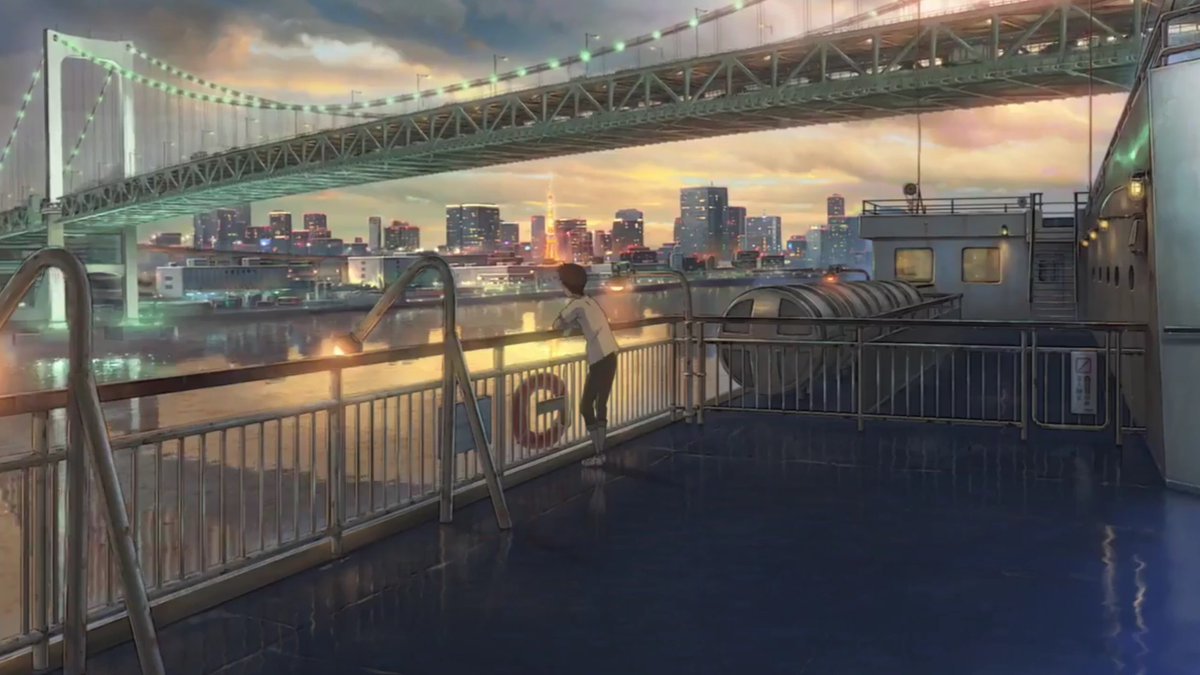
To give a quick rundown of Tenki no Ko's premise for those who aren't aware:
Sixteen-year-old Hodaka Morishima runs away from his home on a distant island and moves to Tokyo, where he struggles to support himself in the bustling city. After landing a live-in job as a tabloid journalist tasked with investigating urban legends and supernatural events, Hodaka meets Hina, a young girl also struggling to support herself and younger brother Nagi. Hodaka learns that Hina has the power to temporarily manipulate the weather, and the two of them set out together to offer a reprieve from the non-stop rain in Tokyo with her ability.
As the film progresses, a series of tragic events unfold, as you've probably already guessed: the weather gets exponentially worse and out of Hina's control, the police come looking for Hodaka and they call social services on Hina, and we learn that Hina has to be sacrificed to the heavens to return the weather to normal, which she does herself before being "rescued" by Hodaka.
There is a mish-mash of genres and ideas in Tenki no Ko that don't quite come together to create a satisfying ending. To quote Nick Dent, "[Tenki no Ko] looks amazing, but it has some trouble deciding what kind of movie it wants to be: tender teen romance, gritty urban drama, apocalyptic climate change metaphor or uplifting fantasy" — a statement that aptly encapsulates the kind of film it is. Yet, this film still has something new to offer.
Shinkai and His Success
Over the years, Makoto Shinkai has established a distinct identity as an anime director through his work. His digital techniques and unique art style have been at the forefront of the modern anime film revolution, particularly thanks to Kimi no Na wa.'s accomplishments. But more importantly, there are the easily relatable themes that flow through his original stories: distance, fate, longing, isolation, connection, the nature of relationships, and so on.
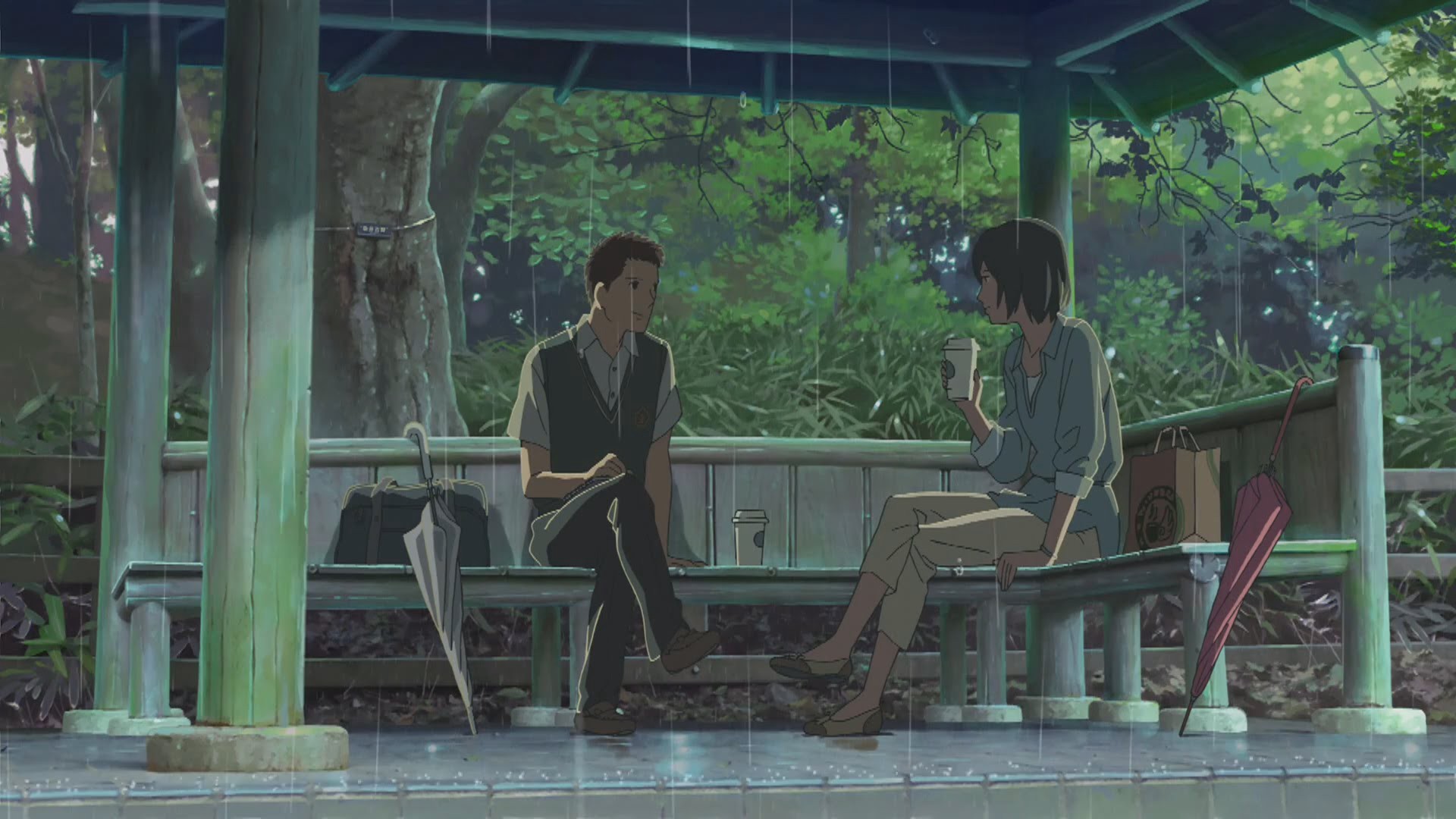
Before Kimi no Na wa., Shinkai was regarded as an "indie" director that was relatively well-known for his beautiful, small-scale films, but Kimi no Na wa. was made to a scale unlike what he had done before, both physically and thematically. In the words of Genki Kawamura, a producer at Toho, Kimi no Na wa. was apparently first conceived as a “best of” compilation of Shinkai's films up until that point. And it certainly was. It brought together teenage love, communicating over a distance, supernatural fantasy, promises and dreams, connection, and more — not to mention how it took another step up in the production elements department. The rest, of course, is history. Many regarded Kimi no Na wa. as the beginning of a new era for both Makoto Shinkai and the anime industry, but it is easy to forget that a new era means the end of an old one, and that is no more apparent than in Tenki no Ko, where familiar themes and ideas are taken to new places.
It's well-established that the rise of Kimi no Na wa. as a cultural phenomenon was primarily driven by young people (teenagers and young adults) and their emotional attachment to its relatable story and characters. The story is set in a very modern world unlike anime films from other prominent directors like Hayao Miyazaki and Mamoru Hosoda. As Shinkai said in an interview with the Los Angeles Times, "Neither one knows it yet, but somewhere out there is a person they are bound to care deeply about. I thought I might be able to encourage today’s young people if I could create a tale that evoked that sort of destiny.” For Tenki no Ko to be "the next Kimi no Na wa.", that same demographic has to find something in the film to emotionally connect with.
Kimi no Na wa. vs. Tenki no Ko
There are several contrasts and comparisons to be made, but there is a simple defining distinction between these two films: Kimi no Na wa. is the pursuit of destiny and Tenki no Ko is the rejection of it. And I don't just mean this in a fantastical sense. Consider Kimi no Na wa.'s concept of "musubi" and the Red Thread of Fate. Taki and Mitsuha are connected by an unknown supernatural force that transcends time, and they believe in and fight for that destiny. In Tenki no Ko, it is that same "will of the heavens" that dictates the fate of Hina as a Weather Maiden — that she must be a sacrifice to restore the weather in Tokyo to normal. However, Hodaka refuses to accept that destiny even though it resolves the never-ending disruptions and impacts that Tenki no Ko depicts over the course of the entire film. These ideas and emotions play into the film's thematic structure and its message for younger audiences.
In an interview with Yahoo! Japan, Shinkai states that Tenki no Ko is a story of "Hodaka's conflict with society" and "the clash between the desire of the individual and the wellbeing of the majority (society)." This defines the pinnacle moment of the film that I'll discuss later. Compared to his previous films, which explore more internal and interpersonal central themes, Tenki no Ko enters a new kind of thematic territory where Shinkai addresses humanity rather than the individual human being. Feelings of isolation born from distance between individuals becomes the alienation of young people from adults, society, and their uncertain futures; the acceptance of changing circumstances through love and loss becomes the unstable mutation of the world and society itself; the reality of the past becomes the reality of the future.
This thematic transformation of Shinkai can also be seen in one of his most prominent motifs: trains.

One of Makoto Shinkai's most revisited themes is trains and how they symbolise both separation and everyday life. In Byousoku 5 Centimeter, we see the torture that Takaki faces on his long journeys to see Akari on trains that falter and consume even more of his limited time; in Kimi no Na wa.'s epilogue, Taki and Mitsuha are helpless as they see each other on separate trains, taking them both away before fortunately reuniting elsewhere. Indeed, this theme is momentarily present in Tenki no Ko. Nearby trains disturb Hina's home with earthquake-like tremors as they pass by, and the increased rainfall in the middle of the story causes all the train lines to be shut down, stalling their escape from the law and inconveniencing everyone else in Tokyo — there is a massive line for taxis outside the train station, and a lightly dressed woman is shown suffering from the cold as a result.
However, this motif evolves in Tenki no Ko when Hodaka escapes from the police to get Hina back from the heavens. He jumps up on the disabled train tracks and runs along them all the way to his goal, the shrine gate that links the sky and the earth, as repair workers and pedestrians look on. Here, sixteen-year-old Hodaka rejects the themes of the past and the restrictions that society has placed upon him as he ignores all warnings directed at him.
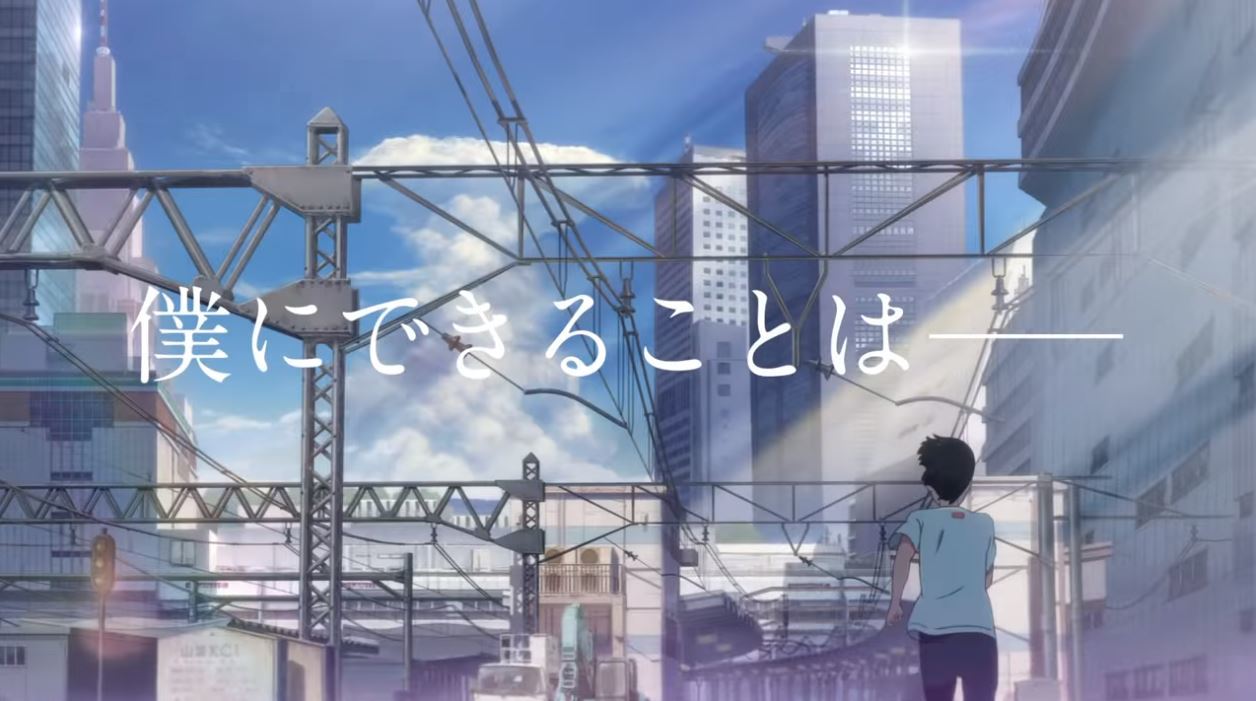
But before this climactic scene, Shinkai subtly addresses the aforementioned new themes of isolation and reality throughout the film. The depiction of Tokyo was perhaps the best I've ever seen in an anime not just for its artistic appeal, but for how well it painted the city's vastness and the variety of its landscape. Hodaka and Hina struggle to live their own lives in the city, constantly restricted by their ages as they seek work and places to stay. There's even direct commentary on youth alienation and past vs. future reality, such as this comment from Keisuke's mother-in-law that's quite on the nose: "I feel sorry for young people nowadays. We used to have such beautiful springs and summers."
As I mentioned previously, Hina lets herself become a sacrifice to the heavens much to the dismay of Hodaka and Nagi, but no one else. Keisuke and the rest of Tokyo are relieved to have the weather back to normal ("Summer's finally back to the way it should be" — a further reflection on how the ideas of the past override the ideas of the future), completely unaware of Hina's sacrifice. Yet Hodaka chooses to bring her back to our world because, as he puts it, "I want you more than any blue sky. The weather can stay crazy."
All in all, both Kimi no Na wa. and Tenki no Ko have some overlap in their themes, but differ greatly in their approach — it's clear that Shinkai sought to present a more profound message in his new film, as further evidenced by a certain visual reference he included.
The Catcher in the Rye
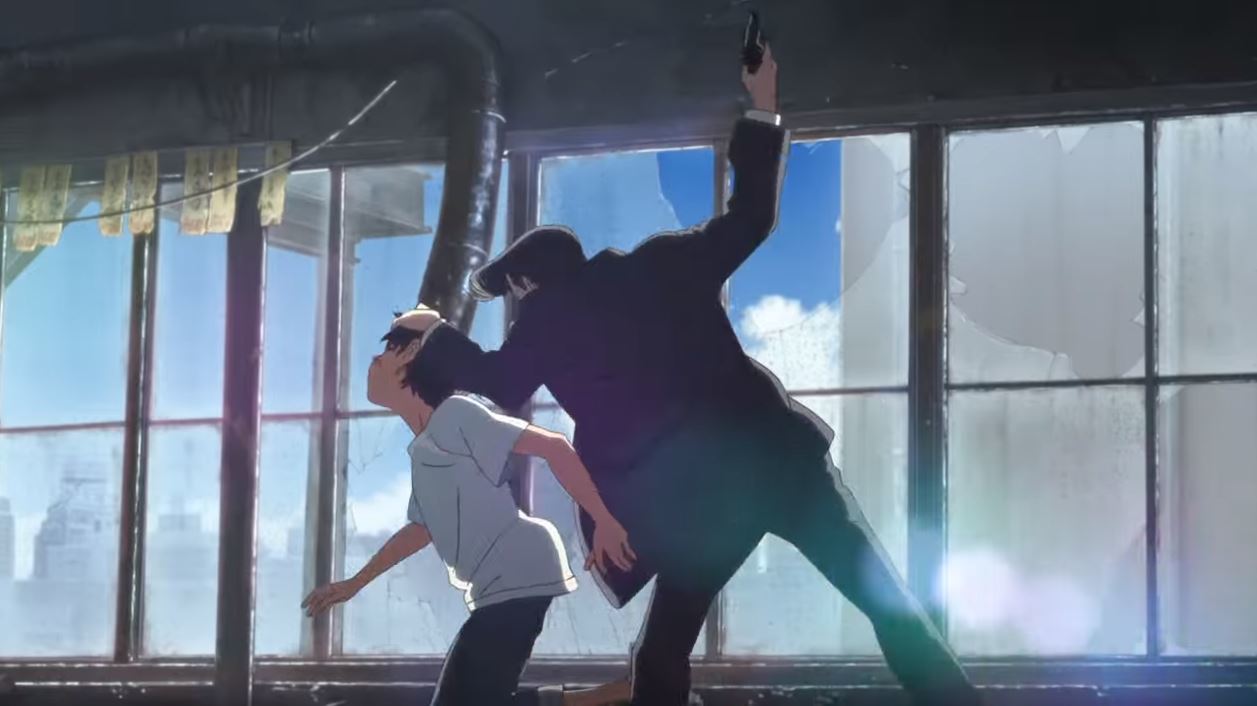
One of the very first shots we get of Hodaka is him sitting on the boat headed to Tokyo as he is running away from home. Quite conspicuously, he is carrying a copy of The Catcher in the Rye. This book makes a reappearance later on, with multiple shots focusing on its cover. Why would a teenager running away from home with very few possessions take this specific book with him? Indeed, it is a somewhat illogical narrative decision. However, linking the film with the book helps contextualise the themes and messages of Tenki no Ko even further. Even though it was published in 1951, The Catcher in the Rye is still regarded as relevant, as an honest reflection of the insecurities countless young people feel in the modern world.
The central theme of The Catcher in the Rye is the protection of innocence, as the main character (Holden Caulfield) struggles against the adult world and its "phoniness." Hodaka himself, who is actually the same age as Holden, says to the police blocking his path, "You all know nothing. You just pretend you don't." By the end of the book, Holden comes to understand that children should be able to "grab for the gold ring" and take their own risks, which is exemplified in Hodaka's choice to rescue Hina and let the rain continue to fall on Tokyo. As they fall through the sky together, Hodaka says "Pray for yourself, Hina," telling her (and the audience) to follow her own destiny and reject the expectations placed upon her by others.
A Bolder Ending
Now, what seems like a happy ending in Tenki no Ko is actually questionable, given what occurs afterward; the fallout from rejecting changing circumstances and the world itself. When Hina and Hodaka return to the ground, the bad weather reappears instantly with what can only be described as an act of vengeance, and we're left wondering if "that's it" as the camera lingers on Hodaka and Hina lying unconscious beneath the shrine gate. But then, time skips ahead by three years and Tokyo is mostly underwater, and that's no exaggeration.
It'd be foolish not to recognise the climate change allegory at play, a topic that is one of, if not the most, concerning problems facing today's youth. But it's not just an illustration of the events to come (Tokyo is predicted to be increasingly underwater due to rising sea levels), it's also about the burden and responsibility that younger generations must bear. When Hodaka is falling through the sky after entering the shrine gate, he's met with a dark, pulsating world filled with roaring winds and terrifying creatures before passing through to the pristine world Hina resides in. It wouldn't surprise me if this was meant as a statement on society's mistreatment of the planet we live on, and the crippling rainfall is the heavens' retaliation against humanity's hubris ("There's always been a world, up in the sky.").
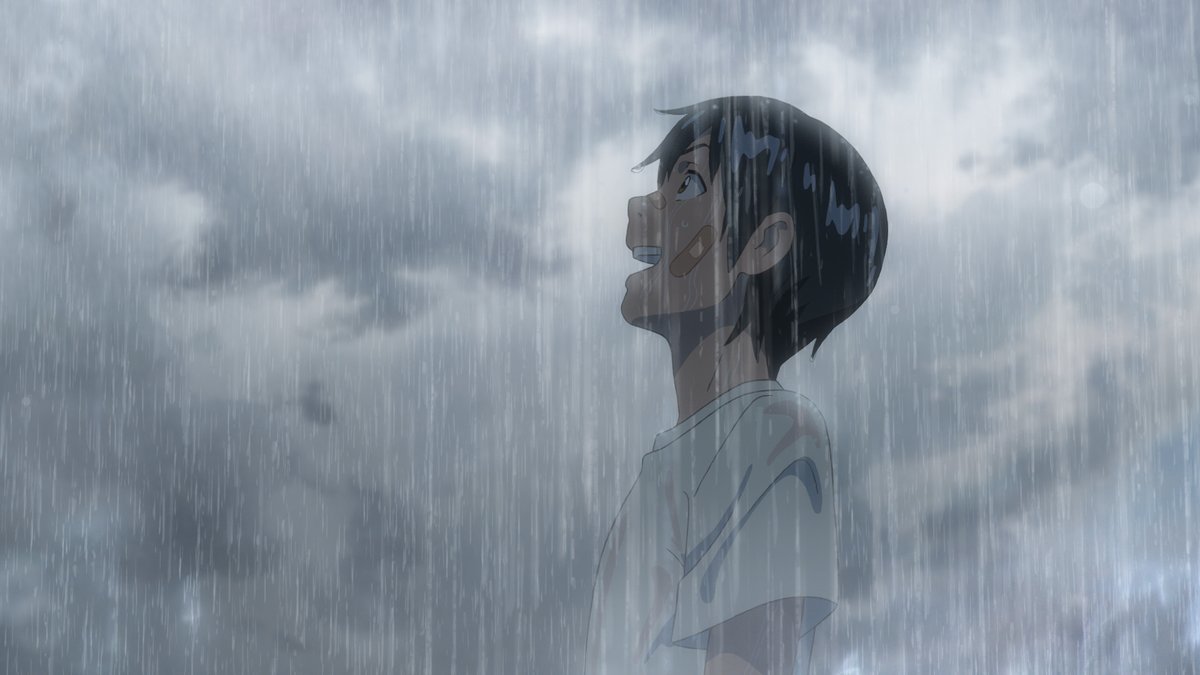
Of course, simply giving up on the person you formed a precious connection with and moving on doesn't make for a particularly enticing ending in a romance film, so the hero gets the girl in the end. But unlike the innocent, happy finale of Kimi no Na wa. and the moments of wisdom made at the end of Byousoku 5 Centimeter and Hoshi no Ou Kodomo, there are consequences to rejecting destiny and following one's desires. The moral question of "is a single life worth sacrificing for the majority" is an all-too-familiar element across all genres of films, books, and other mediums. Whether or not it was the right decision is up to personal opinion, but it's the message it makes that is more important: you can make your own choices. Considering the emphasis on conforming to "the good of society" that's present in Japanese culture, it's a powerful one that is sure to incite conversations.
Makoto Shinkai has ventured into the landscape of youth emotion and desires numerous times, but through Tenki no Ko, he has drawn his broadest strokes yet by capturing the divide that exists between youth and the adult world, the future and the past.
After 3 years apart, Hodaka ponders what to say to Hina upon their reunion, visibly troubled by his past actions. When he goes around visiting past acquaintances, Keisuke tries to comfort him with the line "The world's always been crazy anyway." Eventually, he makes his way to Hina, and Tenki no Ko concludes with these powerful words as they stand by a flooded city:
"It was my choice. I chose her, I chose this world, I chose to live in it."
"Hina, I'm sure… we're gonna be okay."
Conclusion
If there's just one thing to take away from Tenki no Ko, it's that Makoto Shinkai is continuing to evolve as a director.
The return of RADWIMPS, Shinkai's trademark art and animation style, the movie's box office success — in many ways, Tenki no Ko can certainly be called "the next Kimi no Na wa." But when it comes to the underlying subject matter of the film itself, Tenki no Ko represents a fresh step in Makoto Shinkai's filmography that reflects on and reforms the themes that he's become known for.
In the past, Shinkai's films contained themes of introspection, such as emotional distance and connection, but his latest work looks outward while remaining faithful to his roots. Just like in J.D. Salinger's The Catcher in the Rye, one should stay true to themselves, even when faced with the challenges that come with growing up in our current world.



![[Manga Store] Creator Spotlight](https://cdn.myanimelist.net/s/common/uploaded_files/1526365943-ce26b29b5135051da0904ab879f2c431.jpeg)